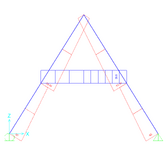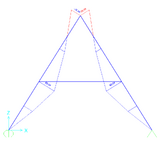Tygra_1983
Student
Hi,
I have the following example where by I am trying to calculate the axial force in the tie beam:

The geometry is: width = 10m, height = 8 metres, angle = 57.995 degrees. The diagonal members are 9.43m (sqrt(89))
And these are the support reactions:

If the tie beam is fully fixed I can take moments about the apex and calculate the axial force of the tie beam member. However, this does not work out with the tie beam being pinned.
In my attempt to solve this I calculate the moment in the joint that connects the tie beam to the main frame, and add that into the equation taking moments about the apex.
The moment at the joint in this example is 63.04 kNm. The pinned connection has both horizontal and vertical components. Hence:

Solving for Ax, gives 30.4 kN
In the software I am getting 28.5 kN. So close, but not completely correct.
Am I going about this the right way?
Thank you in advance!
I have the following example where by I am trying to calculate the axial force in the tie beam:

The geometry is: width = 10m, height = 8 metres, angle = 57.995 degrees. The diagonal members are 9.43m (sqrt(89))
And these are the support reactions:

If the tie beam is fully fixed I can take moments about the apex and calculate the axial force of the tie beam member. However, this does not work out with the tie beam being pinned.
In my attempt to solve this I calculate the moment in the joint that connects the tie beam to the main frame, and add that into the equation taking moments about the apex.
The moment at the joint in this example is 63.04 kNm. The pinned connection has both horizontal and vertical components. Hence:
Solving for Ax, gives 30.4 kN
In the software I am getting 28.5 kN. So close, but not completely correct.
Am I going about this the right way?
Thank you in advance!







